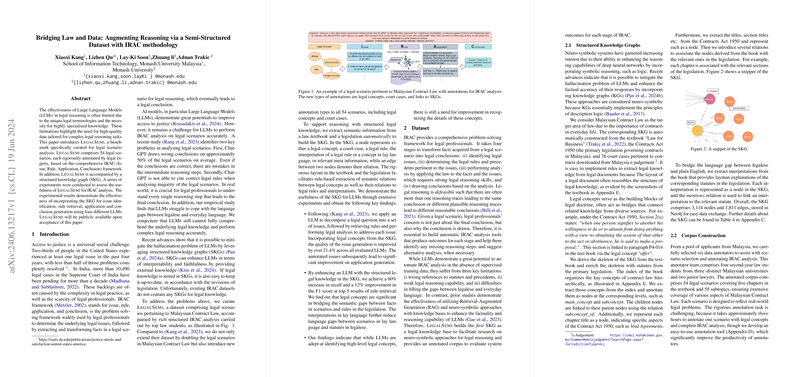Bridging Law and Data: Augmenting Reasoning via a Semi-Structured Dataset with IRAC Methodology
The paper "Bridging Law and Data: Augmenting Reasoning via a Semi-Structured Dataset with IRAC methodology" presents a novel dataset and structured knowledge approach tailored to enhance the legal reasoning capabilities of LLMs. The authors introduce LegalSemi, a benchmark dataset curated specifically for the analysis of legal scenarios, with a focus on Malaysian Contract Law. This dataset leverages the IRAC (Issue, Rule, Application, Conclusion) methodology, a widely recognized framework among legal professionals.
Introduction and Background
Legal professionals frequently employ the IRAC methodology for rigorous legal analysis, requiring a fine-grained understanding and reasoning about legal issues, rules, applications, and conclusions. Despite the high-performance capabilities of state-of-the-art LLMs, their efficacy in legal reasoning remains limited due to the complex and specialized nature of legal knowledge. A significant challenge highlighted by the authors is that current LLMs, such as ChatGPT, struggle with accurate rule retrieval and often make reasoning errors, especially when there is a need to bridge the linguistic gap between legal jargon and everyday language.
Contributions and Dataset Description
The LegalSemi dataset is meticulously curated with 54 legal scenarios in the context of Malaysian Contract Law, annotated with the IRAC framework by expert law students and junior lawyers. It introduces several innovative elements:
- Structured Knowledge Graph (SKG): The SKG integrates comprehensive legal knowledge extracted from a law textbook, legislation, and court cases. The SKG includes nodes representing legal concepts, rules, court cases, and interpretive information, with edges denoting their relationships.
- Annotations: Each legal scenario in LegalSemi is annotated with legal concepts, stages of IRAC analysis, and references to applicable laws and court precedents, thus providing a rich resource for evaluating and training LLMs.
Experimental Setup and Key Findings
The authors conducted extensive experiments using four LLMs: GPT-3.5 turbo, Llama 2, Mistral, and Gemini, to assess the impact of incorporating structured legal knowledge on various IRAC stages.
- Legal Concept Identification: Incorporating legal concepts significantly improved the models' performance in recognizing specific legal terms. For instance, GPT-3.5 turbo demonstrated a remarkable enhancement, with over 21.4% improvement in quality when legal concepts were integrated.
- Issue Identification: Utilizing the SKG for issue generation led to substantial performance gains across all evaluated LLMs. This improvement underscores the importance of specialized legal concepts in refining the high-level accuracy of LLMs in legal reasoning tasks.
- Rule Retrieval: Direct application of LLMs for rule retrieval yielded subpar precision levels, often below 3%. However, leveraging legal concepts through the SKG improved retrieval significantly, achieving up to a 17.2% increase in F1 score in top-5 retrials. This suggests that structured knowledge is critical in mitigating language gaps between legalese and lay language used in scenarios.
- Application and Conclusion Generation: The incorporation of issues and rules into LLM prompts led to noticeable improvements in application generation, with GPT-3.5 turbo exhibiting an 18.9% performance increase. Effective use of application data similarly bolstered accurate conclusion generation, highlighting the layered benefits of a structured, staged approach to legal reasoning.
Implications and Future Research
The inclusion of the SKG in LegalSemi provides a robust neuro-symbolic foundation that enhances the interpretability and factual accuracy of LLMs in legal tasks. This structured approach not only augments the immediate performance of LLMs in IRAC analysis but also sets a precedent for future research to explore more sophisticated neuro-symbolic integrations. The dataset and methodology pave the way for further developments in legal AI, where structured knowledge and domain-specific annotations could significantly elevate the efficacy of automated legal reasoning systems.
Conclusion
The research presented in this paper makes significant strides in addressing the limitations of LLMs in legal reasoning by introducing LegalSemi, a comprehensive dataset for legal scenario analysis enriched with structured knowledge. The paper's experimental results underscore the necessity of integrating specialized legal knowledge to enhance the performance of LLMs across various stages of IRAC analysis. The practical and theoretical implications of this research point to promising future directions in AI, potentially transforming the landscape of automated legal reasoning through the systematic application of structured knowledge.
In conclusion, LegalSemi emerges as a pivotal resource, fostering advancements in the application of AI to legal reasoning and showcasing the powerful synergy between structured legal knowledge and state-of-the-art machine learning techniques.
